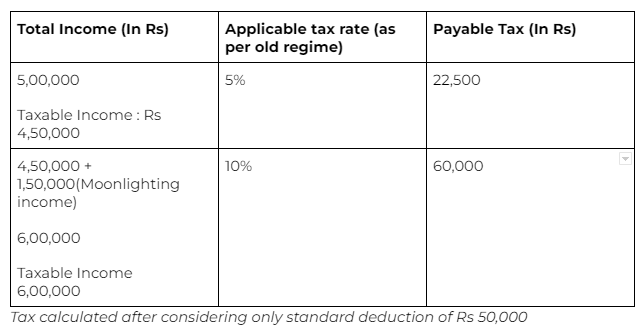Moonlighting? Don’t try to escape I-T’s tax flash
In your ITR, if you file your moonlighting monies under the head “Income from business and profession”, you are marking it as fees for the professional services you’ve delivered.
- Ira Puranik
- Last Updated : August 9, 2023, 10:33 IST

If you’ve been, or are a moonlighter, the IT department is coming for you. For those who have not disclosed their income from this secondary source, the taxmen are sending notices. More than 1,100 notices have been sent so far, mostly for cases between 2019-21. What’s more, investigations for such cases for FY22 are yet to begin.
How to report this?
There are two ways in which you can present this income. The first, though non-ideal and often, non-preferred way is to show it under the head of salary. By doing this, you are clubbing your moonlighting income to your main income. This could lead to being taxed under a higher slab. Moreover, you won’t be able to claim the regular tax deductions twice.
Say Armaan earns Rs 5,00,000 per annum from his regular job, and another Rs 3,00,000 by moonlighting. Here’s how his tax liability will be calculated.

As you can see, clubbing together moonlighting and regular income pushes up Armaan’s tax incidence significantly. Even Manish Gupta, CA, points out, “Most companies don’t encourage dual employment, since it means multiple tax complications. A better, simpler way is to file your moonlight income under the head “Income from business and profession”.
In your ITR, if you file your moonlighting monies under the head “Income from business and profession”, you are marking it as fees for the professional services you’ve delivered.
So, if Armaan shows his moonlighting income of Rs 3,00,000 under this head. Against this income, Armaan has incurred the following expenses:
- Promotional/Advertising services = Rs 20,000
- Stipend/salary paid to intern/employee = Rs 40,000
This brings his total expenditure to Rs 60,000. Hence, his taxable income under the head “Income from business and profession” will come down to Rs 2,40,000, which is tax-free. That is because all expenses borne by the professional in delivering his service can be deducted from the total income before calculating any tax liabilities.
But, to claim these deductions, he will have to formally maintain accounts and furnish them to the IT department? Is there another way he can reduce his tax payment, all while not having to maintain any formal accounts for all these?
Can a presumptive tax scheme help? Under Section 44DA of the IT Act, some professionals, whose income from business and profession does not exceed Rs 75,00,000 in a year, can opt for presumptive taxation. The presumptive income is taken at 50%, on which tax is paid annually. Post this, no other expenses will be considered for tax calculations.
So, if Armaan opts for the scheme, he does not need exact figures of his income and expenses. All he has to do is pay taxes on a specific percentage of his revenue. He will end up paying tax on Rs 1,50,000 (50% of Rs 3,00,000), which again, is free from taxes.

Thanks to presumptive taxation, Armaan was able to markedly bring down his tax liabilities. However, since not everybody can avail this facility, it is generally advised to keep all payment receipts and invoices handy. If you choose to be taxed under presumptive taxation, you will have to opt for it for a continuous period of 5 years.
Serious penalties Hiding your income from the IT department can have serious consequences for you and your pocket. If, on re-assessment, your income is found to be more than what you’ve declared, you will have to pay a penalty of 50% of the tax which will be payable on the under-reported income.
Download Money9 App for the latest updates on Personal Finance.
Related
- Top 25 Best Selling Cars in the US Q1 2025 Ford Leads Tesla Holds, and Sedans Make a Comeback
- Vegan vs Non-Vegetarian: Which Diet Is More Nutritious and Better for Your Health?
- होंडा ने हेडलाइट समस्या को ठीक करने के लिए वापस मंगवाई CB300R मोटरसाइकिलें
- RBI ने लगातार दूसरी बार रेपो दर में कटौती की, कर्ज होंगे सस्ते
- Tata Motors की वैश्विक थोक बिक्री चौथी तिमाही में 3% घटकर 366177 इकाई
- सुरक्षा मानदंडों को पूरा करने की बढ़ती लागत की वजह से दाम बढ़ा रही हैं कार कंपनियां

